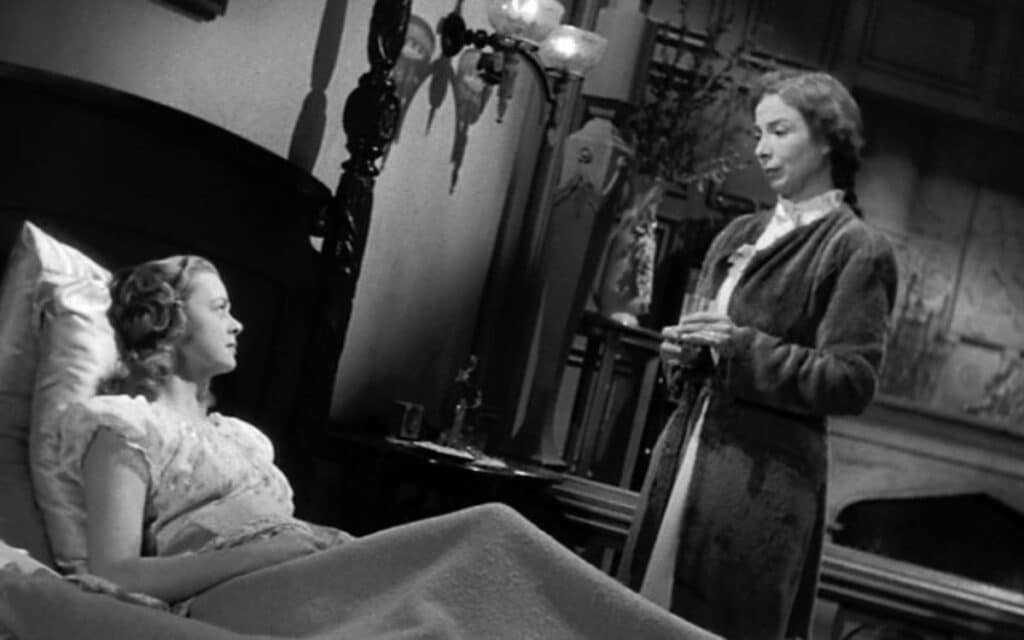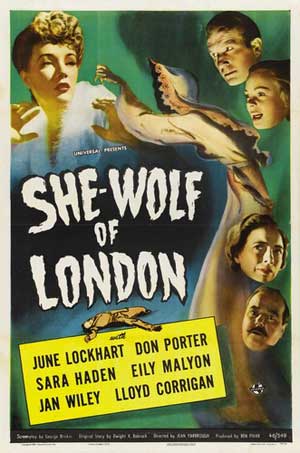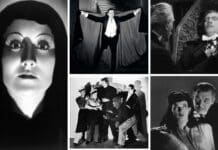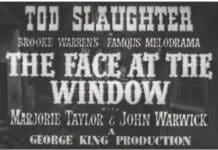She-Wolf of London 1946 surprises viewers by focusing on psychological tension instead of typical werewolf horror, delivering a dark Victorian thriller, writes DAVID SAUNDERSON

TITLE: She-Wolf of London
RELEASED: 1946
DIRECTOR: Jean Yarbrough
CAST: June Lockhart, Don Porter and Sara Haden
Review of She-Wolf of London 1946
Universal Horror is known for its werewolves, but She-Wolf of London 1946 pulls the rug out from under us in a different way, delivering more psychological tension than a typical creature feature.
Don’t expect full moon transformations here, but that doesn’t mean there’s nothing spooky.
Set in Victorian London, the film follows Phyllis Allenby (June Lockhart), a young woman on the verge of marrying her true love, Barry Lanfield (Don Porter).
Her happiness is threatened by a series of murders near her family estate — deaths that suggest a monstrous creature prowling the fog-drenched parks at night.
Soon, Phyllis is plagued by nightmares and begins to fear that she may be the cursed Allenby wolf, destined to continue her family’s lycanthropic legacy.
The eerie atmosphere and moody visuals will keep you on edge as Phyllis sinks deeper into paranoia.
London’s misty streets, creepy mansions and an oppressive sense of dread permeate the entire film.
Director Jean Yarbrough builds tension not through monstrous appearances but through suggestion, leaving you to wonder: is there really a wolf, or is it all in her mind?
Lockhart delivers a solid performance as the tormented Phyllis, convincingly portraying a woman grappling with her own sanity.
Sara Haden, as her stern Aunt Martha, adds a chilling presence to the film, while Don Porter serves as the concerned (if somewhat generic) love interest.

The mystery drags in places, and for those expecting werewolf action, the slow-burn thriller may disappoint.
What you’re waiting for – the claws, fangs, and hair-raising transformations – never arrives. That twist at the end? It reveals that all the supernatural goings-on were a red herring, making this less a horror film and more a tale of psychological manipulation.
Even if you feel cheated by the absence of a true werewolf, there’s still something to enjoy in the film’s gothic atmosphere.
The haunting fog, the moaning winds, and the ever-present feeling of being watched are classic elements of Universal’s horror aesthetic.
Though the special effects are nearly non-existent, the moody soundtrack helps keep the tension high.
Culturally, She-Wolf of London stands as an outlier in Universal’s monster canon.
Coming at the tail-end of their horror boom, it doesn’t lean into the supernatural the way The Wolf Man 1941 or Dracula 1931 did.
Instead, it’s closer to a Victorian melodrama wrapped in a thriller’s skin, more concerned with hidden family secrets than hairy transformations.
By today’s standards, it might not leave a lasting impression, but it’s still an intriguing piece of Universal’s legacy.
For those who enjoy a slow, brooding mystery, She-Wolf of London 1946 has its charms.
However, if you’re seeking a werewolf howling at the moon, you might want to look elsewhere.
As a spooky psychological thriller with plenty of atmosphere, though, it still finds its place on Spooky Isles.
Watch She-Wolf of London 1946
Tell us your views of She-Wolf of London 1946 in the comments section below!







